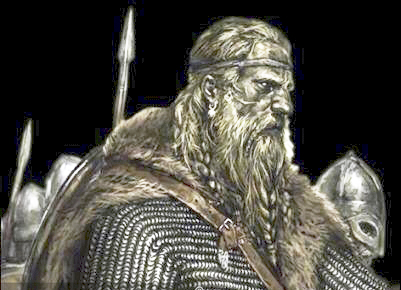Editor’s note: This is the first instalment of ‘Soldados de la bestia—los bersekers y la expansión vikinga’ (Soldiers of the beast—the berserkers and the Viking expansion), originally published in Spanish on May 4, 2013.
______ 卐 ______
‘Furor teutonicus’ (a phrase by Roman chroniclers about the push of the Germans in combat).
‘A furore Normannorum libera nos, Domine’ (‘From the fury of the Northmen deliver us, O Lord’, medieval prayer).
‘The number of boats grows. The endless stream of Vikings never ceases to increase. Everywhere Christians are victims of killings, fires and looting. The Vikings conquer everything on their path. Nobody can face them. They have taken Bordeaux, Périgord, Limoges, Angouleme and Toulouse. Angers, Tours and Orleans have been destroyed. A countless fleet sails Seine up and evil dominates the country. Rouen has been deserted, looted and burned. Paris, Beauvais and Meaux have been conquered; the fortifications of Melun have been demolished; Chartres is occupied, Evreux and Bayeux sacked and many other besieged cities’ (monk Ermentarius of Noirmoutier, France, decade of 860).
The history of the Indo-European peoples teaches us that every great work comes, in its first wave, from the ‘authentic’ and uncontaminated barbarian and from the alliances of warriors or Männerbunden, who are the only ones capable of changing the world and time through direct action. This essay precisely deals with the most remarkable representatives of the Indo-European barbarian and the alliances of warriors.
The sacred rage in the Indo-European tradition
Where did the legendary and furious force of those ancient Indo-Europeans, our ancestors, come from—so united with their gods and to Nature? In ancient times, there are numerous references to that force, which is described as a kind of fury, frenzy or rage. The divine wrath is a whole archetype: the Iranians called it aeschma and the Indo-Iranians, ishmin. In India, the mada was also described—the divine drunkenness produced by the mystical soma drink. In Greece we find the menon or menis, the passionate anger that only Achilles, the greatest warrior of all times, possessed.
Also from Greece comes the ‘divine fury of Dionysus’, which at first had to do with the glorification of the instincts related to the cult of ascending life. The mania, that is to say the outburst of the Dionysian fury, was said to take in a flight the possessed soul towards the Thracian Mountains, which represented a primitive, ancestral and barbaric Hellas. In the Celtic world we find the Irish hero Cú Chulainn from whom the warp spasm (‘spasm that deforms’, or spasm of fury) took over in moments of war, giving it a supernatural thrust. This, in short, tells us that the sacred anger was not exclusive Germanic patrimony, but comes from an even older source, and that in all the Indo-European peoples there were male circles that cultivated the strength given by the fury of combat.
The Germans, an Indo-European people from southern Scandinavia, were perhaps the last Europeans to openly cultivate the sacred anger in a tribal way. The name of the god Wotan makes direct reference to the fury. In modern German wut means rage. In modern English wrath has the same meaning and in Gothic, wods meant possessed. Wotan would be, then, the ‘wrath of An’. An is an archetypal syllable: thus the Sumerians called their main deity.
The divine wrath was not then a novel concept, nor something that has disappeared. When something sacred, a song, a landscape, a ceremony, a passion, a person, a situation, remind us of an inner instinct, what emerges is a very special type of feeling: the union of fury and joy, the feeling that makes the warriors of all times raise their arms to heaven and throw their screams to the wind; the Dionysian feeling that lies in music and songs, that makes us feel more alive and more powerful; the glorious feeling of honour, pride and contact with the Eternal, which accelerates our pulse and frightens the hell out from us; the feeling that we know that nobody but a European man can feel.
‘Burning souls’ Leon Degrelle called them. ‘Fire in the blood’ we could call it, as when sometimes we talk and our ‘blood boils’. It is the spiritual flame that opposes the advance of materialist and nihilistic ice, the ‘warlike ardour’ of which even today is sung in the anthem of the Infantry.

One reply on “Holy wrath, 1”
“In modern German wut means rage. In modern English wrath has the same meaning and in Gothic, wods meant possessed. Wotan would be, then, the ‘wrath of An’. An is an archetypal syllable: thus the Sumerians called their main deity.”
Not in the slightest is this possible. The suffix “-an” is a High German variation of a common Germanic suffix with the original form of “-anaz”. It is used to form a dominant agent from a base noun. An example being the Proto-Germanic word “*þeudanaz” which means leader of a “*þeudo” meaning nation or people. Extant examples of this being found in old Germanic languages all meaning “leader/prince/ruler” include Old Norse “þjóðann”, Old English “þeoden”, Gothic “þiudans” and Old Saxon “Thiodan”. The name of Wotan seems to be structured in the same way, with “Wotan” being the dominator of “Wut” or perhaps a different word. It even follows a similar evolution in pronounciation as the first example with the ending syllables of “Thiodan” and “þeoden” matching the respective names of “Wotan” and its Old English counterpart “Woden”. This becomes even more obvious when the reconstructed name of the God is “*Wodanaz”.
There is literally no reason to connect languages separated by thousands of years and kilometers with no plausible correlation due to one coincidence in spelling. Especially isolates like Sumerian, spoken by people not at all Aryan.